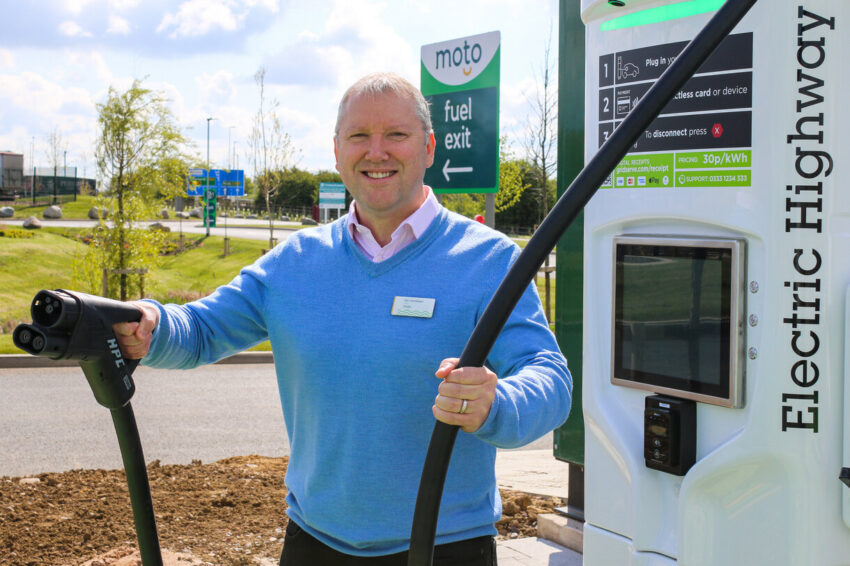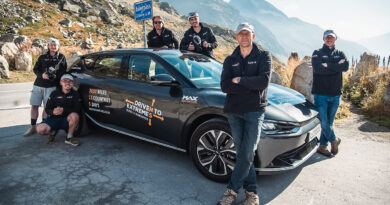The Moto Way
We speak to Ken McMeikan, CEO of Moto Hospitality, about its commitment to electric vehicles and how its partnership with GRIDSERVE is helping electrify the UK’s motorway network.
When did Moto’s interest and commitment to electric vehicle charging begin?
At Moto, we’re driven by our vision of transforming the UK’s rest stop experience and the opportunity to revolutionise the UK motorway network. We have been rolling out EV chargers for more than a decade but over the past two to three years we have taken our commitment to a new level with plans to roll out 350kWh chargers at our sites and create “super hub” charging destinations for motorists, like the one launched at Rugby 18 months ago. Our aim for EV charging is for all drivers to feel super confident when they make the switch from ICE to EV, safe in the knowledge that they don’t need to worry about driving range on UK motorways. By making charging fast, simple and reliable we believe we can continue to give EV drivers this confidence.
How many charging stations are currently in operation across Moto sites in the UK?
We now have more than 300 chargers across Moto sites in the UK as of September 2022. That figure is growing as we continue to launch more EV super hubs with the aim of meeting the Government’s 2023 target of having a minimum of six high power chargers at each of our sites.
What plans are there to grow the number of charging points at motorway hubs?
We’re working relentlessly to roll out high powered charging for all our UK sites as quickly as possible over the next 12-18 months. We are on track to deliver a minimum of six high powered charging points at every Moto site by the end of 2023, in line with the Government’s target and, in a great deal of cases, double or even more than double that number, in order to future-proof our sites and manage the rapidly growing demand for charge points.
What are some of the most significant challenges that come with introducing charging points to motorway services?
The biggest issues we’re facing are managing the requirement for power networks and charging operators to build ahead of demand and the long delivery times associated with bringing charge points online. These long delivery times are attributable to issues with planning, landlord permissions and legal complexity. In addition, further guidance from Government on funding and planning in relation to EVs would help to really accelerate the process at certain locations where the cost of power upgrades is exceptionally high and prohibitive.Specifically, we need better accessibility to the £1 billion fund that the Government has set aside to assist the roll out of the EV charging network across the UK. We’d also like to see local authorities given much more specific guidance on the requirements for MSA provision in order to create a quicker and more streamlined decision-making process in terms of planning consent for both site developments and connections to the power network. From our point of view, this is one of the largest stumbling blocks in accelerating our EV charging capacity and one which the Government can help address to give us the greatest opportunity in delivering for all motorists as they navigate the transition away from ICE vehicles.
In your opinion, do you consider electric vehicles to be the future of all transportation?
EVs currently remain the key alternative to ICE vehicles that can be manufactured, purchased and maintained at scale. Other alternatives may materialise in the longer term, but as things stand, and if we are to ensure that the UK meets its emissions targets now, then we must work to make EVs as accessible to people as possible.This is another reason why Moto fully supports the government’s agenda on green transport, and the faster legislation and guidance can keep pace and support the investments we and others are making, the easier it will be to get the infrastructure in place so motorists are encouraged to switch to EV.
Are there any plans to make future and existing EV chargers more accessible?
Moto takes the safety and wellbeing of all customers very seriously with teams working on-site 24/7 who are able to help customers with any issues they may face. Customers are encouraged to speak to staff in order to resolve or highlight any safety issues they may come across and if anyone is having an issue with accessing a chargepoint we help them access the service if they ask in the main building.All of Moto’s EV bays are extra wide, making them all suitable for disabled access, but, the creation of dedicated disabled EV bays is something that we are looking to progress as the switch to EV gathers pace. For example, we have actively engaged in the development of the latest British Standards Institution’s PAS (Publicly Available Specification) on accessible charging for electric vehicles and fully support the recommendations initially put forward on space surrounding accessible charge points.
What can we expect to see from Moto and Gridserve from now until the end of the year?
We are continuing to revolutionise the motorway rest stop experience together, by launching new electric vehicle super-hubs up and down the country to provide motorists the infrastructure they need to charge their vehicles reliably, simply and quickly. Our partnership brings together one of the UK’s largest provider of EV chargers and the largest provider of motorway services. We’re aligned not only on the delivery of EV chargers but on the manner and scale in which we do it, together. Fundamentally, we want to change how people think of and use motorway service areas and EV charging is a fundamental part of that future.
What are the main USP’s for Moto and Gridserve’s EV chargers?
Moto is committed to ensuring that it can provide an exceptional EV charging service across its network and is focused on reliability, simplicity and speed. As our network expands, we’re doing all we can to ensure that customers can always rely on charge points at Moto sites. Moto conducts regular maintenance checks on all its charging points to ensure they are fully operational so drivers can be confident about their ability to charge at Moto. GRIDSERVE also remotely monitor charging points, both proactively, and reactively for issues reported by customers. Where issues with a charge point at a Moto site are detected and can’t be fixed remotely, an engineer will be sent out the same day if reported before 1pm. For customers requiring extra support, GRIDSERVE also operates a 24/7 hotline, 365 days a year. All this means that GRIDSERVE averages 99% reliability across its network – including at Moto sites. We also know how important ease of charging point use is to EV motorists – particularly to those new to EV ownership. All the GRIDSERVE Electric Super Hubs at MOTO locations have been designed to feature both CCS and CHAdeMO connectors, accept contactless payments and provide at least one extra-wide accessible charging bay for every six EV charging spaces. With real-time status updates shared with a myriad of the most popular EV charging maps, including Zap-Map, drivers can have complete confidence in the rapidly expanding network, knowing the availability of chargers before arriving at MOTO’s sites.And, last but not least our GRIDSERVE 350kW-capable high power chargers are supplied by renewable, net zero carbon energy can deliver up to 100 miles of range in less than ten minutes so our EV customers can recharge their cars fast.






